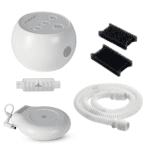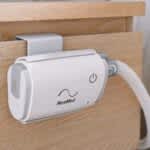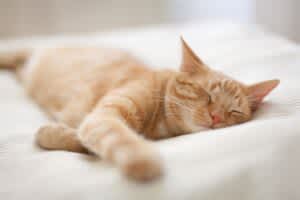Around 60% of cat owners and 50% of dog owners sleep with their pets, despite often having vastly different sleep schedules. We’ll discuss how much cats sleep and what to expect from your cat’s sleep habits.
How Many Hours a Day Do Cats Sleep?
Adult cats can sleep 16 hours per day, and this number often increases as they age. A study of cats aged 11 and up found that most slept between 12 and 18 hours a day, though a significant number slept more. In addition to sleeping more, it is natural for older cats to show less interest in active pursuits, such as hunting and playing outside, preferring instead to spend quiet time with their owners.
How Long Do Cats Sleep?
On average, throughout a 24-hour period, cats sleep for about 79 out of every 104 minutes. Unlike humans, who tend to sleep in one long time period at night, cats have a polyphasic sleep schedule that is marked by multiple shorter bouts of sleep across both day and night. In general, cats tend to be more active at night and sleep more during the day. Male and female cats do not appear to need different amounts of sleep.
What Happens During Cat Sleep?
The sleep stages cats experience can be generally categorized into rapid eye movement (REM) sleep, non-rapid eye movement (NREM) sleep, and another distinct stage, which is a transition period that occurs between NREM and REM sleep. Cats tend to enter NREM sleep first. They may wake up after a bout of NREM sleep or transition to REM sleep.
NREM Sleep
Researchers have identified rhythmic brain waves in cats that are similar to the slow wave sleep, or deep sleep, that is also seen in humans.
Like humans, cats also experience sleep spindles, which are bursts of quicker brain waves that occur during non-rapid eye movement (NREM) sleep. In humans, sleep spindles are thought to play a role in memory, as well as help maintain sleep by blocking out disruptions. Cat sleep spindles differ somewhat from human sleep spindles, but they also occur during the transition to REM sleep, and researchers believe they serve more or less the same functions.
REM Sleep
During REM sleep, cats display quick eye movements, brain activity that resembles waking, and a general loss of muscle tone with occasional twitches. Domestic cats may obtain three to eight hours of REM sleep per day.
Researchers believe eye movements during REM sleep may represent the sleeper taking in dream imagery. In keeping with this theory, older studies have found evidence that cats may dream.
Rapid eye movement sleep in cats was discovered very early on, and cats were often used in sleep research in the 20th century. Although researchers have identified many similarities in the structures that control sleep in humans and cats, more research is needed to understand how a cat’s brain waves during sleep might change as a result of learning, aging, or other factors.
A cat’s breathing rate generally slows during sleep. Quicker breathing when your cat transitions to sleep may indicate an underlying health issue.
How Are Cat Sleep Habits Different From Humans'?
Whereas most humans are active during the day and obtain the majority of their sleep at night, recent studies suggest that cats follow a 24-hour cycle with two peaks in activity: one at dawn and one at dusk. Researchers theorize this bimodal pattern may have evolved because cats hunt both birds and rodents, with birds being more active in the daytime and rodents being more active at night.
Studies have found that in addition to the peaks in activity at dusk and dawn, some cats are primarily awake during the day, and some are primarily awake at night. The vast differences observed between cats may reflect individual adaptations of each cat according to their particular prey. Household cats may also adapt their activity patterns around mealtimes, exposure to daylight, access to the outdoors, and other cats. Cats who spend more time with their owners are more likely to adapt their activity patterns accordingly.
When to Be Concerned About Your Cat's Sleep
Talk to your vet if you notice concerning changes to your cat’s sleep, especially if these are accompanied by other symptoms such as significant weight loss, increased crying at night, changes in grooming and activity, or aggressive or less social behavior. Cats can develop a number of health conditions, such as arthritis, kidney disease, blindness, deafness, and sleep disorders such as sleep apnea and narcolepsy, but there are ways to improve their quality of life.
































